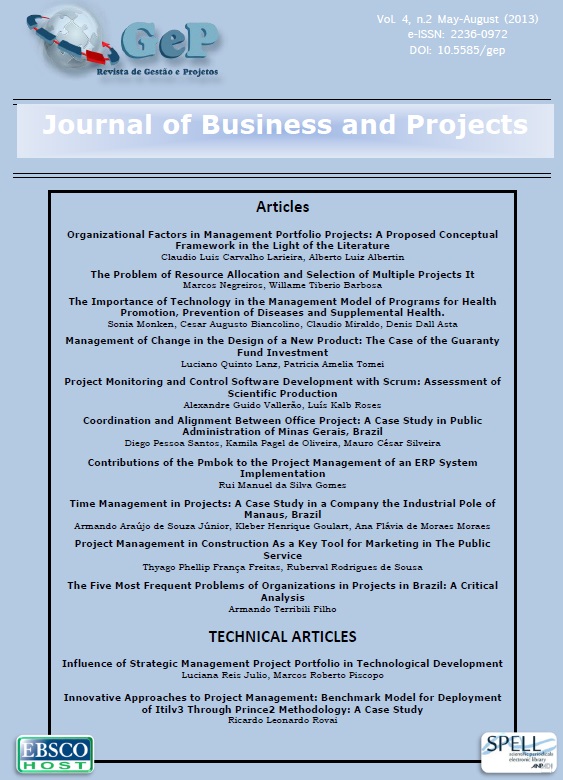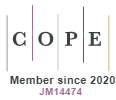Project Monitoring and Control Software Development with Scrum: Assessment of Scientific Production
DOI:
https://doi.org/10.5585/gep.v4i2.154Keywords:
Scrum, métodos ágeis, monitoramento e controle, bibliometriaAbstract
The main objective of this study is to perform a bibliometric evaluation on control and monitoring processes in software development projects managed through Scrum method, covering the last five years of scientific production. For this, a bibliometric research was conducted for publications in Capes – papers, dissertations and thesis – and Web of Knowledge databases, when the relevance of the papers found was determined by h-index. Based on the publications selected, it was identified the main approaches about those monitoring and control processes. The research outcomes indicate a small amount of scientific production related to monitoring and control in software development projects under agile methods, even smaller for those under Scrum method, which suggests research opportunities and related increase of scientific production about this theme. Indeed, the analysis of the publications approaches suggests the balance of monitoring and control mechanisms of agile and traditional methods as an emergent theme.
References
Agile Manifesto. (2001). Manifesto for agile software development. Recuperado em 15 maio, 2013, de http://www.agilemanifesto.org.
Barton, B., Schwaber, K., & Rawsthorne, D. (2007). Reporting Scrum project progress to executive management through metrics. In J. Sutherland & K. Schwaber (Orgs.). The Scrum Papers: Nuts, Bolts, and Origins of an Agile Process (pp. 101-108). Newton: Patient Keeper.
Beck, K. (1999). Extreme Programming Explained: Embrace change. Boston: Addison-Wesley Professional.
Capes. (2013). Qualis periódicos. Recuperado em 20 outubro, 2013, de http://www.capes.gov.br/avaliacao/qualis.
Cervino, M. A. R. C. (2011). Avaliação do Nokia Test e Indicadores de Desempenho em Ambientes de Desenvolvimento de Software. Dissertação de Mestrado, Fundação Universidade de Pernambuco, Recife, PE, Brasil.
Cockburn, A. (2002). Agile Software Development Joins the "Would-Be" Crowd. Cutter IT Journal, 15(1), 6-12.
Cockburn, A., & Highsmith, J. (2001). Agile software development, the people factor. Computer, 34(11), 131-133.
Concas, G., Marchesi, M., Destefanis, G., & Tonelli, R. (2012). An empirical study of software metrics for assessing the phases of an agile project. International Journal of Software Engineering and Knowledge Engineering, 22(04), 525-548.
Conforto, E. C. (2009). Gerenciamento ágil de projetos: proposta e avaliação de método para gestão de escopo e tempo. Dissertação de Mestrado, Universidade de São Paulo, São Carlos, SP, Brasil.
Conforto, E. C., & Amaral, D. C. (2010). Evaluating an agile method for planning and controlling innovative projects. Project Management Journal, 41(2), 73-80.
Deemer, P., Benefield, G., Larman, C., & Vodde, B. (2010). The scrum primer: A lightweight guide to the theory and practice of Scrum (Versão 2.0). Recuperado em 15 maio, 2013, de http://www.goodagile.com/scrumprimer/scrumprimer20.pdf.
Dingsoyr, T., Nerur, S., Balijepally, V., & Moe, N. B. (2012). A decade of agile methodologies: Towards explaining agile software development. Journal of Systems and Software, 85(6), 1213-1221.
Dyba, T., & Dingsoyr, T. (2008). Empirical studies of agile software development: A systematic review. Information and software technology, 50(9), 833-859.
Ferreira, A. G. C. (2010). Bibliometria na avaliação de periódicos científicos. DataGramaZero - Revista de Ciência da Informação, 11(3), 1-9.
Fowler, M. (2000). Put Your Process on a Diet, Software Development Magazine, 2(12), 32-39.
Guedes, V. L., & Borschiver, S. (2005). Bibliometria: uma ferramenta estatística para a gestão da informação e do conhecimento, em sistemas de informação, de comunicação e de avaliação científica e tecnológica. Encontro Nacional de Ciência da Informação, 6, 1-18.
Highsmith, J. (2000). Retiring Lifecycle Dinosaurs: A look at Adaptive Software Development, an alternative to traditional, process-centric software management methods. Software testing and quality engineering, 2, 22-30.
Highsmith, J. (2009). Agile project management: creating innovative products (2nd ed.). Boston: Pearson Education.
Highsmith, J., & Cockburn, A. (2001). Agile software development: The business of innovation. Computer, 34(9), 120-127.
Hirsch, J. E. (2005). An index to quantify an individual's scientific research output. Proceedings of the National academy of Sciences of the United States of America, 102(46), 16569-16572.
Hodgson, D., & Briand, L. (2013). Controlling the uncontrollable: ‘Agile’ teams and illusions of autonomy in creative work. Work, Employment & Society, 27(2), 308-325.
Indelicato, G. (2012). Making Sense of Agile Project Management: Balancing Control and Agility. Project Management Journal, 43(3), 78-78.
ISACA. (2012). COBIT 5 Control Objectives for Information and related Technology: Enabling Processes (versão 5). Rolling Meadows: IT Governance Institute.
Mahnic, V., & Zabkar, N. (2012). Measuring Progress of Scrum-based Software Projects. Electronics and Electrical Engineering, 18(8), 73-76.
Mariz, L. M. R. S. (2009). Um Estudo Experimental sobre Gestão de Equipes e Sucesso de Projetos de Software que Utilizam Scrum. Dissertação de Mestrado, Universidade Federal de Pernambuco, Recife, PE, Brasil.
Marnewick, C., & Labuschagne, L. (2011). An investigation into the governance of information technology projects in South Africa. International Journal of Project Management, 29(6), 661-670.
Maruping, L. M., Venkatesh, V., & Agarwal, R. (2009). A control theory perspective on agile methodology use and changing user requirements. Information Systems Research, 20(3), 377-399.
Mchugh, O., Conboy, K., & Lang, M. (2012). Agile practices: The impact on trust in software project teams. Software, IEEE, 29(3), 71-76.
Miranda, E., & Bourque, P. (2010). Agile monitoring using the line of balance. Journal of Systems and Software, 83(7), 1205-1215.
Moe, N. B., Dingsoyr, T., & Dyba, T. (2009). Overcoming barriers to self-management in software teams. Software, IEEE, 26(6), 20-26.
Pereira, T. M. (2013). Fatores Críticos na Aceitação de um ERP por seus Usuários. Dissertação de Mestrado, Universidade Católica de Brasília, Brasília, DF, Brasil.
Persson, J. S., Mathiassen, L., & Aaen, I. (2012). Agile distributed software development: enacting control through media and context. Information Systems Journal, 22(6), 411-433.
Pichler, R. (2010). Agile product management with scrum: Creating products that customers love. Boston: Addison-Wesley Professional.
Pikkarainen, M. (2009, junho). Towards a Better Understanding of CMMI and Agile Integration-Multiple Case Study of Four Companies. Proceedings of Product-Focused Software Process Improvement, Oulu, Finlândia, 10.
Project Management Institute. (2011). Pulse of profession 2012. Newtown Square: PMI.
Project Management Institute. (2012). PMI Agile Certified Practitioner (PMI-ACP). Recuperado em 6 abril, 2013, de http://www.pmi.org/~/media/Files/PDF/Certification/PMI-ACP_Practitioner_FAQ_March2012.ashx.
Project Management Institute. (2013). A Guide to the Project Management Body of Knowledge (PMBOK Guide). Newtown Square: PMI.
Santos, A. B. (2011). Um método para gerenciamento de custos em projetos de software desenvolvidos com método Scrum. Dissertação de Mestrado, Instituto de Pesquisas Tecnológicas do Estado de São Paulo, São Paulo, SP, Brasil.
Santos, A. F., S., Jr. & Dos Santos, R. P. (2009, junho). Aspectos Sociotécnicos do Desenvolvimento de Software Utilizando Scrum em um Caso Prático. Anais do Workshop Um olhar Sociotécnico sobre a Engenharia de Software – WOSES, Ouro Preto, MG, Brasil, 5.
Schubert, A. (2009). Using the h-index for assessing single publications. Scientometrics, 78(3), 559-565.
Schwaber, K. (1995, outubro). Scrum development process in Business object design and implementation. Proceedings of OOPSLA Workshop, Austin, Texas, Estados Unidos, 6.
Schwaber, K. (2004). Agile Project Management with Scrum. Readmond: Microsoft Press.
Sheffield, J., & Lemétayer, J. (2013). Factors associated with the software development agility of successful projects. International Journal of Project Management, 31(3), 459-472.
Software Engineering Institute. (2011). CMMI® for Development, version 1.3: Improving processes for developing better products and services. Pittsburg: Carnegie Mellon University.
Souza, M. M. (2010). Uma Proposta para Aplicar Análise Quantitativa de Riscos em Projetos de Software Ágeis. Dissertação de Mestrado, Universidade Federal de Pernambuco, Recife, PE, Brasil.
Sutherland, A. C., Sutherland, J., & Hegarty, C. (2009, agosto). Scrum in church: Saving the world one team at a time. Proceedings of Agile Conference, Chicago, Illinois, Estados Unidos, 9.
Takeuchi, H., & Nonaka, I. (1986). The new new product development game. Harvard business review, 64(1), 137-146.
Versionone. (2013). 7th State of Agile Development Survey: The state of agile development. Atlanta: Version One Inc.
Weaver, P. (2007). Effective project governance-linking PMI’s standards to project governance. Proceedings of PMI Global Congress, Hong Kong.
Web of Knowledge. (2013). Web of Knowledge Help: h-index. Recuperado em 20 maio, 2013, de http://images.webofknowledge.com/WOKRS510B3_1/help/WOK/hp_citation_report_hindex.html
Downloads
Published
How to Cite
Issue
Section
- Abstract 482
- PDF (Português (Brasil)) 294








